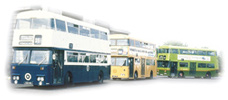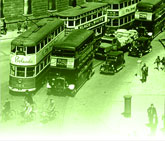 |
||||||||||||
 |
||||||||||||
 |
||||||||||||
 |
||||||||||||
 |
||||||||||||
| Passenger Transport This category - trams, trolleybuses, buses and coaches - illustrates the public transport scene in Ireland since 1945: CIE, the Dublin United Tramways Co. and the Great Northern Railway, form its core. Ulsterbus, Belfast Corporation (now Citybus) and private operators are also represented, covering every part of Ireland. Belfast, Dublin and Dundalk coachbuilders are among those whose work is preserved. |
||||||||||||
| The march of the Leyland Titan | ||||||||||||
| Back when buses were favoured over trams, Leyland promoted their Titan bus range with the slogan ‘When you bury a tram, mark the spot with a Titan’. It worked; 220 of them replaced 330 Dublin trams from 1938-40. | ||||||||||||
| The AEC Regent – ahead of its time | ||||||||||||
| Introduced in 1929, and designed by the famous J.G. Rackham, the AEC Regent double-deck and single-deck buses became particularly well known in Ireland as they plied their routes around the countryside | ||||||||||||
| Alas Atlantean | ||||||||||||
| It was the Atlantean that saw off the front-engined double-decker, and while CIE were initially unimpressed with the new concept, it wasn’t long before they ordered a massive 341 of them — all of which were assembled in Dublin | ||||||||||||
| The Hill of Howth Tramway and tram No. 9 | ||||||||||||
| Although only two miles apart on the railway, Howth and Sutton stations on the north coast of the Howth peninsula were connected in 1901 by the Hill of Howth Tramway, five and a quarter miles long. The line, built and operated by the Great Northern Railway, reached 365 feet above sea level at the Summit Station, three miles from Sutton. Opened in 1901, this most famous of tramways unfortunately never made a profit and CIE, which took over the GNR in October 1958, closed it down on 31st May 1959. The depot and power station were at Sutton, electricity generation ceasing when an ESB supply was substituted in the early 1930s. | ||||||||||||
| Dublin United Tramways and tram No. 253 | ||||||||||||
| On 16th May 1896, Dublin's first electric trams began running between Haddington Road and Dalkey. Initially operated by the Dublin Southern District Tramways Company, the line was sold a few months later to the Dublin United Tramways, at that time running about 170 horse cars over 33 route miles. | ||||||||||||
| Replicating a tram of 100 years ago | ||||||||||||
| Easily one of the most popular vehicles currently on display in the Transport Museum, tramcar No. 224 is in fact an impostor – but one with a splendid story to tell. | ||||||||||||
| The real Celtic Tiger | ||||||||||||
|
The real Celtic Tiger is alive and well in the Howth transport museum — where its throaty purr can be heard regularly as it revs up before heading off to appear in yet another movie. |
||||||||||||
| The pride of Dundalk — GNR Gardner buses | ||||||||||||
|
Here we recall the designing and building of true classic buses in Dundalk |
||||||||||||
| Coaches the bedrock of tourism — Royal Tigers | ||||||||||||
|
Here we acknowledge the part played by coaches in developing our tourist industry, and the Royal Tiger is one of the outstanding vehicles in the Transport Museum collection. |
||||||||||||
| Royal Tiger buses | ||||||||||||
|
The Celtic Tiger may be resting for 2002, but here we remember another Tiger who formed a relationship with the horizontal way back in 1937 |
||||||||||||